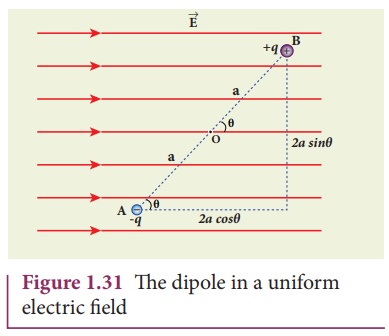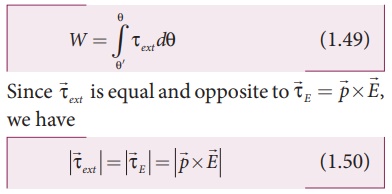Chapter: 12th Physics : Electrostatics
Electrostatic potential energy of a dipole in a uniform electric field
Electrostatic potential energy of a dipole in a
uniform electric field
Consider a dipole placed
in the uniform electric field ![]() as shown in the Figure
1.31. A dipole experiences a torque when kept in an uniform electric field
as shown in the Figure
1.31. A dipole experiences a torque when kept in an uniform electric field ![]() . This torque rotates the dipole to align it with the direction of the electric field.
. This torque rotates the dipole to align it with the direction of the electric field.

To rotate the dipole (at constant angular velocity) from its
initial angle θ’ to another angle θ
against the torque exerted by the electric field, an equal and opposite
external torque must be applied on the dipole.
The work done by the
external torque to rotate the dipole from angle θ’ to θ at constant angular velocity is

Substituting equation
(1.50) in equation (1.49), we get

This work done is equal
to the potential energy difference between the angular positions θ and θ′.
U (θ) −U (θ ′)= ∆U = − pE cos θ + pE cosθ′
If the initial angle is θ′ = 90 and is taken as
reference point, then U (θ′) = pE cos 90 = 0 .
The potential energy
stored in the system of dipole kept in the uniform electric field is given by

In addition to p and E,
the potential energy also depends on the orientation θ of the electric dipole
with respect to the external electric field.
The potential energy is
maximum when the dipole is aligned anti-parallel (θ = π) to the external
electric field and minimum when the dipole is aligned parallel (θ = 0) to the
external electric field.
EXAMPLE 1.16
A water molecule has an
electric dipole moment of 6.3 × 10-30 Cm. A sample contains 1022
water molecules, with all the dipole moments aligned parallel to the external
electric field of magnitude 3 × 105 N C-1. How much work
is required to rotate all the water molecules from θ = 0º to 90º?
Solution
When the water molecules
are aligned in the direction of the electric field, it has minimum potential
energy. The work done to rotate the dipole from θ = 0º to 90º is equal to the
potential energy difference between these two configurations.
W= ∆U =U (90º)−U (0º)
From the equation
(1.51), we write U = − pE cosθ, Next we calculate the work done to rotate one
water molecule from θ = 0º to 90º.
For one water molecule
W = −pE cos 90º + pE
cos0º = pE
W = 6 . 3×10− 30
× 3 ×105 = 18 .9×10−25 J
For 1022
water molecules, the total work done is
Wtot = 18. 9
×10− 25 ×1022 =18 .9×10−3 J
Related Topics